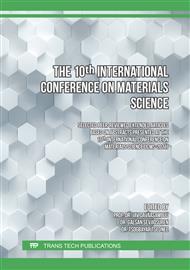[1]
C.M. Wang, X.Y. Luo, X. Zhu, G.K. Cui, D. Jiang, D.S. Deng, L. Haoran, D. Sheng, The strategies for improving carbon dioxide chemisorption by functionalized ionic liquids, J. RSC Advances. 36 (3) (2013) 15518–15527.
DOI: 10.1039/c3ra42366b
Google Scholar
[2]
C.H. Yu, C.H. Huang, C.S. Tan, A review of CO2 capture by absorption and adsorption, Aerosol Air Qual Res. 12 (5) (2012) 745–769.
DOI: 10.4209/aaqr.2012.05.0132
Google Scholar
[3]
P.A. Hunt, Quantum chemical modeling of hydrogen bonding in ionic liquids, Chem. Soc. Rev. 44 (2015) 1257–1288.
Google Scholar
[4]
K.S. Egorova, E.G. Gordeev, V.P. Ananikov, Biological activity of ionic liquids and their application in pharmaceutics and medicine, Chem. Rev. 117 (2017) (10) 7132-7189.
DOI: 10.1021/acs.chemrev.6b00562
Google Scholar
[5]
R.L. Vekariya, A review of ionic liquids: applications towards catalytic organic transformations, J. Mol. Liq. 227 (2017) 44–60.
DOI: 10.1016/j.molliq.2016.11.123
Google Scholar
[6]
S.J. Zeng, X.P. Zhang, L. Bai, X.C. Zhang, H. Wang, J.J. Wang, D. Bao, M.D. Li, X.Y. Liu, S.J. Zhang, Ionic liquid-based CO2 capture systems: structure, interaction and process, Chem. Rev. 117 (2017) (14) 9625–9673.
DOI: 10.1021/acs.chemrev.7b00072
Google Scholar
[7]
V. Plechkovan, K.R. Seddon, Applications of ionic liquids in the chemical industry, Chem. Soc. Rev. 37 (2008) 123–150.
Google Scholar
[8]
P. Wasserscheid, T. Welton, Ionic liquids in synthesis, Wiley-VCH, New York, 2007.
Google Scholar
[9]
D. Fu, P. Zhang, L.X. Du, Progress in CO2 capture using amino acid ionic liquid promoted amine aqueous solutions, Energy Sci. Eng. 30 (2014) (3) 1–4.
Google Scholar
[10]
S. Saravanamurugan, A.J. Kunov-Kruse, R. Fehrmann, A. Riisager, Amine-functionalized amino acid-based ionic liquids as efficient and high-capacity absorbents for CO2, Chem. Sus. Chem. 7 (3) (2014) 897–902.
DOI: 10.1002/cssc.201300691
Google Scholar
[11]
I. Niedermaier, M. Bahlmann, C. Papp, C. Kolbeck, W. Wei, S.K. Calerón, M. Grabau, P.S. Schulz, P. Wasserscheid, H.P. Steinrück, F. Maier, Carbon dioxide capture by an amine functionalized ionic liquid: fundamental differences of surface and bulk behavior, J. Am. Chem. Soc. 136 (1) (2014):436-41.
DOI: 10.1021/ja410745a
Google Scholar
[12]
J.S. Wilkes, A short history of ionic liquids—from molten salts to neoteric solvents, Green Chemistry. 4(2) (2002) 73-80.
DOI: 10.1039/b110838g
Google Scholar
[13]
T.L. Greaves, C.J. Drummond, Protic ionic liquids: properties and applications. Chem. Rev. 108 (1) (2008) 206-237.
DOI: 10.1021/cr068040u
Google Scholar
[14]
A.R. Katritzky, R. Jain, A. Lomaka, R. Petrukhin, M. Karelson, A.E. Visser, R.D. Rogers, Correlation of the melting points of potential ionic liquids (imidazolium bromides and benzimidazolium bromides) using the CODESSA program. J Chem Inf Model. 42 (2) (2002) 225-231.
DOI: 10.1021/ci0100494
Google Scholar
[15]
Z. liu, R. Liu, E. Hua, J.L. Yi, Water effects on physicochemical properties of protic ionic liquid with N-hexylamine as cation and bis(trifluoromethylsulfonyl) imide as anion, Chem. Eng. J. 40 (4) (2021) 2270-2277.
DOI: 10.1007/s10953-021-01067-6
Google Scholar
[16]
X.C. Zhang, Y. Xu, E. Hua, Hydrogen bonding study on protic ionic liquids composed of N-alkylethylenediaminium cations with bis(trifluoromethylsulfonyl)imideanion, Journal of Shihezi University (Natural Science). 38 (5) (2020) 540-547.
DOI: 10.1016/j.mtcomm.2021.102633
Google Scholar
[17]
Y. Zhao, D.G. Truhlar, The M06 suite of density functionals for main group thermochemistry, thermochemical kinetics, noncovalent interactions, excited states, and transition elements: two new functionals and systematic testing of four M06-class functionals and other functionals, Theor Chem Acc. 120 (1) (2008) 215-241.
DOI: 10.1007/s00214-007-0310-x
Google Scholar
[18]
R.G. Parr, W. Yang, Density-functional theory of atoms and molecules, Oxford University Press, New York, 1989.
Google Scholar
[19]
E.D. Bates, R.D. Mayton, I. Ntai, J.H. Davis, CO2 capture by a task-specific ionic liquid. J. Am. Chem. Soc. 124 (6) (2002) 926-7.
DOI: 10.1021/ja017593d
Google Scholar
[20]
W. Wu, B.X. Han, H.X. Gao, Z.M. Liu, T. Jiang, J. Huang, Desulfurization of flue gas: SO2 absorption by an ionic liquid. Angew. Chem. Int. Ed. 43 (18) (2004) 2415-7.
DOI: 10.1002/anie.200353437
Google Scholar
[21]
Y WU, T T ZHANG, N YU, Interaction between 1-Ethyl-3-Methyl-Imidazolium cation and asparagine anion, ACTA PHYS-CHIM SIN. 25 (08) (2009) 1689-1696.
DOI: 10.3866/pku.whxb20090823
Google Scholar
[22]
R.F.W. Bader, Atom in Molecules: A Quantum Theory. Oxford University Press, Clarendon Press, Oxford, 1990.
Google Scholar
[23]
J.M. Campo, J.L. Gázquez, R.J. Alvarez-Mendez, A. Vela, The reduced density gradient in atoms. Int. J. Quantum Chem. 112 (22) (2012) 3594-3598.
DOI: 10.1002/qua.24241
Google Scholar
[24]
H. Roohi, K. Ghauri, Exploring physicochemical properties of the nanostructured Tunable Aryl Alkyl Ionic Liquids (TAAILs). J. Mol. Liq. 209 (2015) 14-24.
DOI: 10.1016/j.molliq.2015.05.001
Google Scholar
[25]
S.F. Boys, F. Bernardi, The calculation of small molecular interactions by the differences of separate total energies: some procedures with reduced errors, J. Mol. Phys. 19 (1970) 553–566.
DOI: 10.1080/00268977000101561
Google Scholar
[26]
H. Watanabe, H. Doi, S. Saito, M. Matsugami, K. Fujii, R. Kanzaki, Y. Kameda, Y. Umebayashi, Hydrogen bond in imidazolium based protic and aprotic ionic liquids, J. Mol. Liq. 217 (2016) (217) 35–42.
DOI: 10.1016/j.molliq.2015.08.005
Google Scholar
[27]
J.A. George. An introduction to hydrogen bonding, Oxford University Press,1997.
Google Scholar
[28]
A.E. Reed, L.A.F. Curtiss, Weinhold intermolecular interactions from a natural bond orbital, donor-acceptor viewpoint. Chem. Rev. 88(6) (1988) 899–926.
DOI: 10.1021/cr00088a005
Google Scholar
[29]
P.A. Hunt, C.R. Ashworth, R.P. Matthews R. Hydrogen bonding in ionic liquids, Chem. Soc. Rev. 44 (5) (2015) 1257-1288.
DOI: 10.1039/c4cs00278d
Google Scholar



